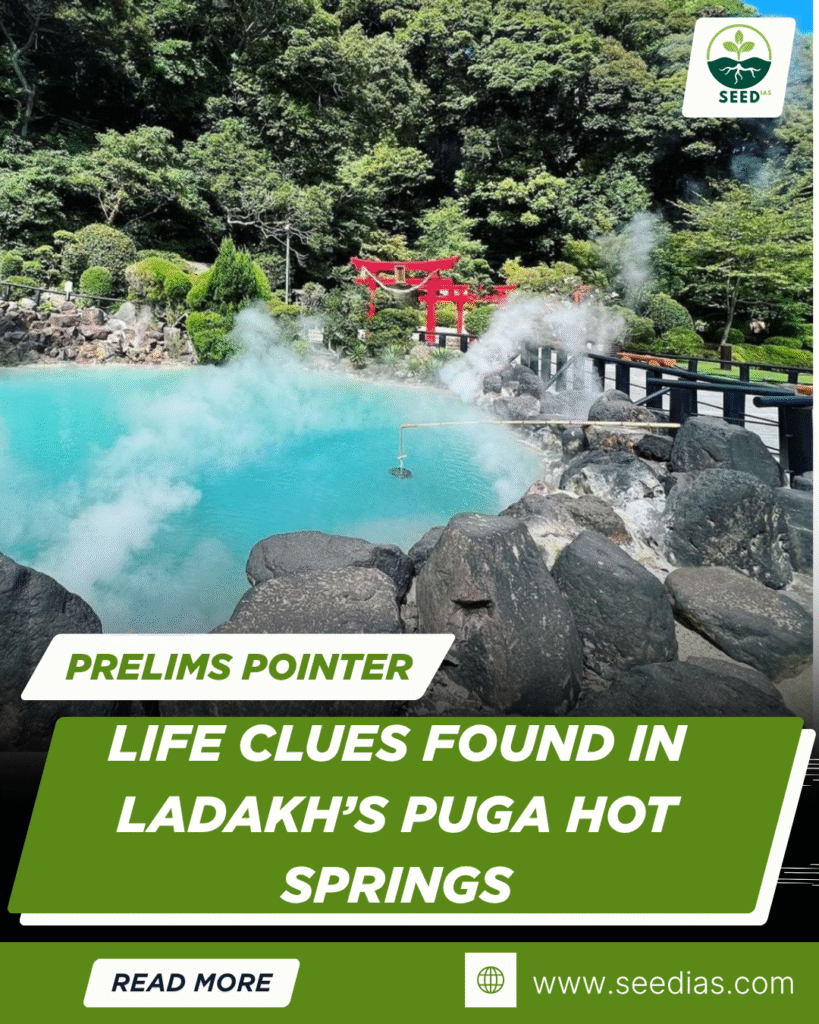Why in NEWS
Scientists have discovered travertine deposits in Puga Valley, Ladakh, which can trap prebiotic molecules like amino acids and fatty acids. This finding supports the theory that life may have originated in geothermal environments, similar to early Earth or Mars.
Key Terms and Concepts
| Term | Explanation |
|---|---|
| Travertine | A form of calcium carbonate deposited by hot springs; can trap organic molecules |
| Prebiotic Molecules | Molecules like amino acids and formamide that may have preceded life |
| Biosignatures | Chemical indicators of past or present life |
| GC-MS-MS | Gas Chromatography with Triple Quadrupole Mass Spectrometry, used to detect trace molecules |
Key Findings from Puga Valley Study
| Feature | Details |
|---|---|
| Location | Puga Valley, southeastern Ladakh — a known geothermal region |
| Discovery | Travertine deposits capable of preserving biosignatures such as amino acids, fatty acids, and formamide |
| Methods Used | GC-MS-MS, Raman Spectroscopy, XRD, IR Spectroscopy, Stable Isotope Geochemistry, Microscopy |
| Significance | Challenges earlier silica-based life origin theories by showing calcium carbonate’s potential as a prebiotic reactor |
| Astrobiology Link | May assist ISRO’s missions by refining biosignature detection on Mars-like terrains |
Hot Springs vs. Geysers
| Feature | Hot Springs | Geysers |
|---|---|---|
| Nature of Flow | Continuous flow of heated water | Intermittent eruption of steam and water |
| Cause | Heated groundwater surfaces | Superheated groundwater explosively vents due to pressure release |
| Example (India) | Manikaran, Badrinath | Rare in India |
| Example (Global) | Yellowstone Hot Springs (USA) | Old Faithful Geyser, Yellowstone National Park (USA) |
In a Nutshell
Memory Code – H.O.T.S.P.R.I.N.G.
Hosts prebiotic molecules
Origin of life clues
Travertine over silica
Spectroscopy and XRD used
Puga Valley’s geothermal setting
Resembles early Earth/Mars
ISRO’s biosignature roadmap
New theories emerging
Geysers vs. hot springs explained
Prelims Practice Questions
- The presence of which of the following in travertine deposits supports theories of prebiotic chemistry?
A. Chlorophyll
B. Fatty acids and formamide
C. DNA strands
D. Methane hydrates - Consider the following statements about geysers and hot springs:
1. Hot springs have eruptive activity at regular intervals.
2. Geysers result from superheated underground water being forced out.
Which of the above is/are correct?
A. 1 only
B. 2 only
C. Both 1 and 2
D. Neither 1 nor 2 - Which of the following techniques was used in the Puga Valley study to detect biosignatures?
1. Raman Spectroscopy
2. Infrared Spectroscopy
3. X-ray Diffraction
Select the correct answer:
A. 1 and 2 only
B. 2 and 3 only
C. 1 and 3 only
D. 1, 2 and 3
Prelims Answers and Explanations
| Qn | Answer | Explanation |
|---|---|---|
| 1 | B | Fatty acids and formamide are key prebiotic molecules found in the deposits |
| 2 | B | Geysers have eruptive activity; hot springs flow continuously |
| 3 | D | All three techniques—Raman, IR, and XRD—were used to study the deposits |
















